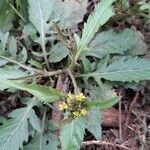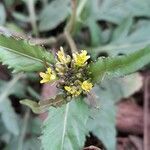Annuals; usually glabrous, rarely sparsely pubescent. Stems (simple or branched from base), erect or ascending, branched proximally and distally, (0.4-)1.5-3.3(-4.5) dm, (glabrous or sparsely pubescent proximally). Basal leaves not rosulate; blade margins pinnatifid. Cauline leaves petiolate (to 4 cm) or (distal) sessile; blade lyrate-pinnatipartite or undivided, obovate, oblong, or lanceolate, (2-)3-11(-15) cm × (5-)10-30(-50) mm, (lateral lobes smaller than terminal), base auriculate or not, margins entire, irregularly crenate, or serrate (entire or serrulate distally). Racemes elongated. Fruiting pedicels divaricate, straight, (2-)3-8(-10) mm. Flowers: sepals erect, oblong-linear, (2-)2.5-3 × 0.5-0.7 mm; petals (usually absent), yellow, linear or narrowly oblanceolate, 1-1.5 × 0.2-0.7 mm, (shorter than sepals); median filaments 1.5-2.8 mm; anthers oblong, 0.5-0.8 mm. Fruits siliques, straight, linear, (15-)25-40 × 0.7-0.9(-1) mm; ovules 70-90 per ovary; style 0.2-1(-1.5) mm, (stout, as thick as fruit). Seeds uniseriate, reddish brown, ovate-orbicular, 0.5-0.8 mm (0.4-0.6 mm diam.), foveolate. 2n = 32, 48.
A cabbage family herb. It grows each year from seed. It grows 15-33 cm tall. The stems can branch from the base. The leaves on the stems can have wings. The leaves may or may not be divided.


